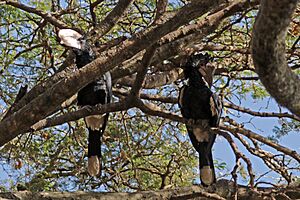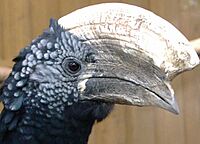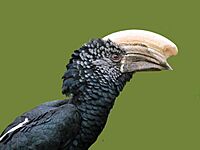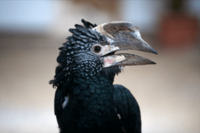Silvery-cheeked hornbill facts for kids
Quick facts for kids Silvery-cheeked hornbill |
|
|---|---|
 |
|
| Male (left) and female (right) Amora Gedel Park, Awassa, Ethiopia |
|
| Conservation status | |
| Scientific classification | |
| Genus: |
Bycanistes
|
| Species: |
brevis
|
| Synonyms | |
|
Ceratogymna brevis |
|
The silvery-cheeked hornbill (Bycanistes brevis) is a large and amazing bird found in Africa. These hornbills live in the tall, green forests of East Africa, stretching from Ethiopia all the way to South Africa. While their homes are sometimes threatened in places like Zimbabwe, they are still quite common in the northern and central parts of their range.
Contents
What Does a Silvery-cheeked Hornbill Look Like?
This hornbill is about 75 to 80 centimeters (about 30 inches) long. It has a very large, cream-colored growth on top of its beak called a casque.
The bird's head is silver-grey. The rest of its feathers are a shiny, iridescent black. This means they shimmer with different colors in the light. However, some parts are white, including its rump, lower back, thighs, and the tips of its outer tail feathers.
Male and female silvery-cheeked hornbills look quite similar. The main difference is that the female has a smaller casque. She also has reddish skin around her eyes.
What Do Silvery-cheeked Hornbills Eat?
Silvery-cheeked hornbills are omnivorous. This means they eat both plants and animals. Their diet includes fruits, insects, and even small animals. They also hunt small birds, rodents, tiny reptiles, and centipedes.
How Do Silvery-cheeked Hornbills Behave?
These hornbills usually live in pairs. Sometimes, hundreds of them will gather together to sleep in large groups.
Life Cycle and Reproduction
Silvery-cheeked hornbills typically breed in the spring, around September and October in some areas. The female lays one to three white eggs. These eggs are kept warm for about 40 days until they hatch. The young birds stay with both parents for about 80 days after hatching.
Images for kids






